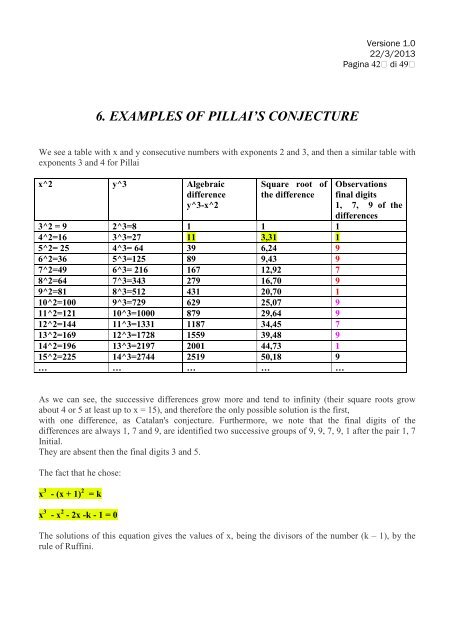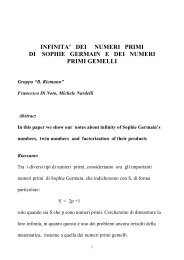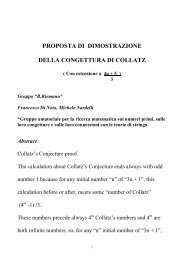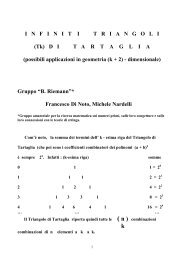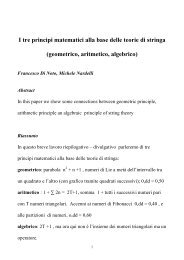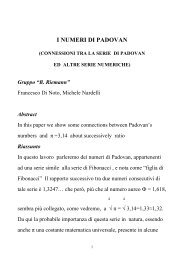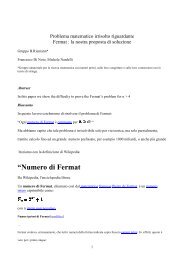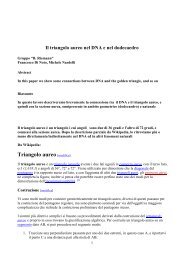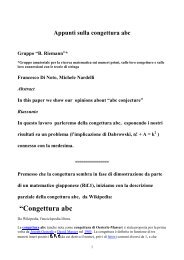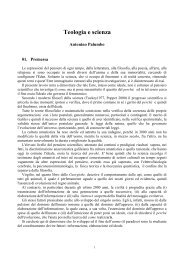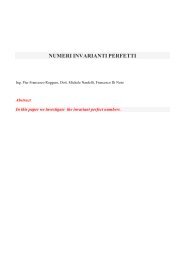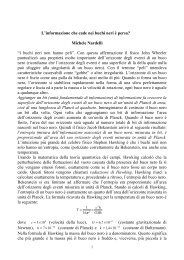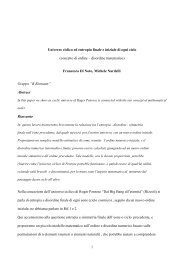proof of fermat-catalan conjecture through the ... - Nardelli - Xoom.it
proof of fermat-catalan conjecture through the ... - Nardelli - Xoom.it
proof of fermat-catalan conjecture through the ... - Nardelli - Xoom.it
Create successful ePaper yourself
Turn your PDF publications into a flip-book with our unique Google optimized e-Paper software.
Versione 1.022/3/2013Pagina 42 di 496. EXAMPLES OF PILLAI’S CONJECTUREWe see a table w<strong>it</strong>h x and y consecutive numbers w<strong>it</strong>h exponents 2 and 3, and <strong>the</strong>n a similar table wi<strong>the</strong>xponents 3 and 4 for Pillaix^2 y^3 Algebraicdifferencey^3-x^2Square root <strong>of</strong><strong>the</strong> difference3^2 = 9 2^3=8 1 1 14^2=16 3^3=27 11 3,31 15^2= 25 4^3= 64 39 6,24 96^2=36 5^3=125 89 9,43 97^2=49 6^3= 216 167 12,92 78^2=64 7^3=343 279 16,70 99^2=81 8^3=512 431 20,70 110^2=100 9^3=729 629 25,07 911^2=121 10^3=1000 879 29,64 912^2=144 11^3=1331 1187 34,45 713^2=169 12^3=1728 1559 39,48 914^2=196 13^3=2197 2001 44,73 115^2=225 14^3=2744 2519 50,18 9… … … … …Observationsfinal dig<strong>it</strong>s1, 7, 9 <strong>of</strong> <strong>the</strong>differencesAs we can see, <strong>the</strong> successive differences grow more and tend to infin<strong>it</strong>y (<strong>the</strong>ir square roots growabout 4 or 5 at least up to x = 15), and <strong>the</strong>refore <strong>the</strong> only possible solution is <strong>the</strong> first,w<strong>it</strong>h one difference, as Catalan's <strong>conjecture</strong>. Fur<strong>the</strong>rmore, we note that <strong>the</strong> final dig<strong>it</strong>s <strong>of</strong> <strong>the</strong>differences are always 1, 7 and 9, are identified two successive groups <strong>of</strong> 9, 9, 7, 9, 1 after <strong>the</strong> pair 1, 7In<strong>it</strong>ial.They are absent <strong>the</strong>n <strong>the</strong> final dig<strong>it</strong>s 3 and 5.The fact that he chose:x 3 - (x + 1) 2 = kx 3 - x 2 - 2x -k - 1 = 0The solutions <strong>of</strong> this equation gives <strong>the</strong> values <strong>of</strong> x, being <strong>the</strong> divisors <strong>of</strong> <strong>the</strong> number (k – 1), by <strong>the</strong>rule <strong>of</strong> Ruffini.


